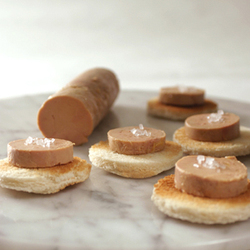DAY THREE: Creating
the torchon. Remove the plastic
wrap from the foie gras and scrape off
excess seasonings. Set both lobes on a piece
of parchment paper and begin to press them
into the shape of rectangular brick. Once
you have formed a kind of "brick," roll it
back and forth to soften the edges to create
a spherical log shape. Keep in mind that
foie gras is like modeling clay; don’t be
afraid of doing something wrong, because you
can always press it back in the desired
shape.Discard the parchment paper and
wrap the log in two layers of cheesecloth,
twisting both ends tightly to keep the log
intact. Tie the ends.
In a large saucepan, bring the stock to a
simmer. Place the torchon into the
simmering liquid.. and don't step away from
the pan! It should simmer for just 1 1/2
minutes. Remove and plunge into an
ice-water bath for 3 to 4 minutes; remove
and pat dry. Some of the foie might have
leaked out of the ends of the cheesecloth;
wipe it away and re-twist the cheesecloth.
Place in the refrigerator overnight.
NEXT: Make the brioche dough.
Brioche
1/2 cup lukewarm water (115°F)
1 (1/4 ounce) package active dry yeast
1 1/4 cups cake flour
1 cup all-purpose flour
1/4 cup sugar
1 teaspoon salt
3 large eggs
1 stick plus two tablespoons butter, cut
into 1/2 inch slices, at room temperature
In a bowl, combine the
water and the yeast together with 1
tablespoon of sugar. Let it sit for 10
minutes, or until the surface of the water
becomes foamy, a sign that the yeast is
working!
In a mixer with a dough hook,
combine the flours, the rest of the sugar
and salt. Add the eggs, one a time,
alternating with some of the yeast water.
When all ingredients have been added, beat
slowly, scraping the sides with a spatula.
Add the butter, one
tablespoon at a time, beating for a minute
after each addition, until all the butter is
incorporated. Beat the dough on medium-high
speed for about 5 minutes. Remove the dough
from the mixing bowl; it should be soft and
elastic to the touch. Place into an oiled
bowl and cover with a dishtowel; let it rest
in a warm place until the dough is nearly
doubled in size, about 2 hours.
Punch the dough down and remove
from the bowl. Place on a floured
surface and knead for 5 to 10 minutes.
Return to the bowl; cover with plastic and
refrigerate overnight. You may refrigerate
it longer than that if you wish, but
remember to punch down the dough every day.
When you are ready to make the
brioche bread, place the dough on a
floured work surface and divide into two
equal parts. Place each piece into a
buttered mini loaf pan (5 3/4 x 3 /14 x 2
1/4) and let them sit, covered, in warm
place until the dough has risen above the
top of the pan.
Cook in a 350°oven for 25 to 30
minutes, or until the tops are
golden brown and the edges begin to pull
away from the sides. Remove them from a pan
and let them cool on a wire rack for at
least 15 minutes before you slice them.
 DAY
FOUR: All your hard work pays off!
Peel away the cheesecloth from the foie gras
log, and slice into 3/4-inch rounds. Arrange
them on a plate and serve with mixed greens
salad (recipe below), cornichons, and
toasted brioche slices. It is also nice to
have something sweet on the plate; a quince
paste is lovely, as is a sour cherry jam.
Figs are in season right now, too, and the
flavor of the figs together with the foie
gras is orgasmic.
DAY
FOUR: All your hard work pays off!
Peel away the cheesecloth from the foie gras
log, and slice into 3/4-inch rounds. Arrange
them on a plate and serve with mixed greens
salad (recipe below), cornichons, and
toasted brioche slices. It is also nice to
have something sweet on the plate; a quince
paste is lovely, as is a sour cherry jam.
Figs are in season right now, too, and the
flavor of the figs together with the foie
gras is orgasmic.
To round out your luxurious meal, enjoy a
white Burgundy or nice rosé, or ~ if you're
celebrating ~ crack open the champagne!
Mixed Greens Salad
2 cups mixed baby greens
1/2 cup chopped assorted herbs: tarragon,
basil, thyme, chives
1/8 cup extra virgin olive oil
One lemon
Salt
Freshly cracked black pepper
In a salad bowl, toss the greens and
herbs together. Drizzle with olive oil; toss
to coat. Squeeze lemon over the salad; toss
again. Season with salt and pepper to taste.
Serve immediately.
Worried about the ducks?
Read what
Sonoma Foie Gras says about the subject.






